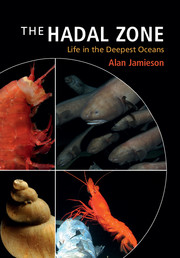Part III - The hadal community
Published online by Cambridge University Press: 05 February 2015
Summary
Introduction
This part details all that is currently known about the different forms of life in the hadal zone. In an ideal world, the taxa should be split into easily navigable sections in taxonomic order, but the hadal community is not as well known as many other environments and there are several taxa on which a disproportionate amount of information is available. Therefore, the next four chapters are divided into sections that cover the type of organisms found using different sampling methods. Chapter 7, Microbes, protists and worms, includes the types of organisms largely found in sediment cores. Chapter 8, Porifera, Mollusca and Echinodermata, incorporates the types of invertebrate epifauna that are encountered using trawls and sledges. Chapter 9, Crustacea, are largely represented by amphipods caught by baited trap, but other crustaceans have also been included for consistency. Chapter 10 details the current knowledge concerning Cnidaria and fish, most of which is derived from baited camera observations or plankton net hauls. For completeness, the Cnidaria section also includes the sessile Anthozoa, which are often recovered via trawl or dredge, or filmed by ROV.
Representatives of most marine organisms are found at hadal depths and each class heralds its own interesting groups. For example, the most diverse and commonly sampled groups are the polychaetes (Annelidea, ~164 species), bivalves (Mollusca, ~101 species), gastropods (Mollusca, ~85 species) and holothurians (Echinodermata, ~59 species). All of these groups are found at full ocean depth and in most cases are found in large aggregations, particularly the holothurians.
- Type
- Chapter
- Information
- The Hadal ZoneLife in the Deepest Oceans, pp. 125 - 126Publisher: Cambridge University PressPrint publication year: 2015

